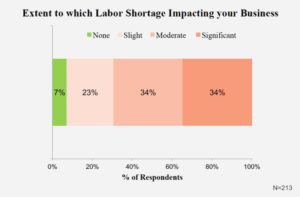A Guest Blog Post from GAF
First posted in June 2017, this article has been updated with 2018 data including findings from the GAF Contractor Labor Shortage Survey conducted at the 2018 GAF Wealth Builder conference, current industry trends, and insights from NRCA CEO Reid Ribble.
It seems everybody wants to climb the job ladder, but no one wants to climb a ladder on the job.
According to a Job Openings and Labor Turnover Survey from the Bureau of Labor Statistics, roughly 200,000 construction jobs sit unfilled in the U.S. The demand for residential homes is far outpacing our capacity to build them. A recent survey by HomeAdvisor lays it out in bleak terms: Of the firms surveyed, 93 percent said they believed the labor shortage is standing in the way of their growth.
Those findings were precisely echoed by the GAF Contractor Labor Shortage Survey, which found only 7 percent of contractors surveyed reported the labor shortage was not having any effect on their businesses. The biggest issues identified were finding talent and project delays.

Today, thousands of small businesses from coast to coast are feeling the effect. Of the more than 1,000 construction firms participating in the 2018 Construction Outlook Survey, 75 percent predicted a need to expand their headcount in 2018 — up two points from 2017. Unfortunately a majority of firms expect it will either become harder or remain difficult to recruit and hire qualified workers in 2018.”
In other words, three out of four of these firms see opportunity on the horizon, but only one in five believe they’ll be able to hire enough professionals to capitalize on it.
The GAF Wealth Builder survey suggests a similar trend. More than two-thirds of responding contractors reported the labor shortage has had a moderate or significant impact on their business. Difficulty finding talent and project delays were the biggest negative impacts.
Because there are so many more roofing jobs available than crews to install them, it has become, in many ways, a seller’s market for labor.
Where have all the workers gone?
There are possibly as many theories about the vanishing labor force as there are jobs waiting to be filled. But labor and industry experts often cite these three factors as driving the phenomenon:
The Housing Bubble – During the housing crisis of 2006-08, the construction industry lost approximately 40 percent of its workforce to other career paths, and those workers have, for the most part, not returned. Despite steady growth in demand for new houses, there is a lingering perception that construction — and residential construction in particular — is not a stable career choice. Making matters worse, when a million professionals walked away from construction, they took their hard-earned expertise.
Youth Perception – In recent decades, the perceived value of craft careers, and the training they demand has suffered a dramatic downturn. Not only has vocational education funding dried up in schools across the country, but the emphasis on “college for everyone” has created an impression that the trades are somehow less worthy career paths. Despite the popular desire for every young person to earn a college degree, more than 30 percent of U.S. high school students never complete four years of college. That means they enter the job market with neither a college degree nor the skills-based training they need to thrive in roofing, construction, manufacturing, or other non-degree careers. And the general dismissal of craft occupations appears to be self-perpetuating. The fewer people we prepare for careers in the trades, the less attractive those careers become. According to a 2017 poll of 2,001 young adults, ages 18 to 25, conducted for the National Association of Home Builders (NAHB), only 3 percent of those with career plans saw themselves working in construction. When asked what motivated respondents to choose a career, 76 percent overall said the career was something they were interested in and 48 percent said it suited their skills and abilities. Could this explain the lack of enthusiasm for craft careers? Can we expect students to dream of using skills that we no longer teach in their schools?
When asked what can be done to help the labor shortage, contractors participating in the GAF Wealth Builder survey most often indicated that focusing on trades in high school would be valuable

When asked to rate their agreement with ways to improve the labor issues, shifting the perceptions of roofing with young people had the greatest level of agreement among respondents.
Changing Demographics – As political and law enforcement spotlights burn brightly on the complex challenges of the U.S. immigration policy, one fact remains indisputable – as the Baby Boom generation ages into retirement, new immigrants currently account for all of the growth in the labor force. Research from NAHB indicates nearly 30 percent of the U.S. construction labor force is foreign-born and even higher for roofing workers at 43 percent. NAHB’s findings show overall 53 percent of the immigrant labor force was born in Mexico. Yet immigration (authorized and unauthorized) has slowed significantly in recent years, putting additional stress on employers looking for skilled construction labor.
National challenges demand national solutions
The National Roofing Contractors Association (NRCA) has been confronting these issues aggressively under the leadership of CEO Reid Ribble. As a former roofing contractor and former U.S. Representative from Wisconsin’s 8th District, Ribble has studied the problem from professional and policy perspectives.
“Listening to some of the national rhetoric about immigration some have a tendency to demonize the immigrant who wants to work here,” Ribble says. “I understand the difference between an undocumented immigrant and one who comes here legally. The latter — the one coming here legally — came here to work. And that’s a good thing.”
Ribble adds when sheer demographics are considered, 10,000 U.S. workers are retiring every day, and the workforce must be supplemented with immigrant labor. Combined with declining birth rates, there simply will not be enough workers to grow the economy without them.
He also has made industry perception a key focus of his work, recently concluding a nationwide tour of allied industry groups, trade gatherings such as the International Roofing Expo, and manufacturer conferences. His consistent message has been a call to reevaluate how we see ourselves.
“We can’t expect anyone to respect what we do until we respect what we do,” Ribble says. “As we begin to shift our own attitude on what we do and the importance of our work, the marketplace will automatically begin to follow us.”
Ribble is calling on the roofing industry to change the way those in the U.S. think about roofing.
“When you walk into a room and flip a switch, you just expect the lights to go on. When you flush a toilet or turn a tap, you expect the plumbing to respond. And when you call an electrician or a plumber, you look for a certified contractor,” he says. “We expect our roofs to perform, as well, so why don’t we look for master-level certification of our roofers? The roofing industry needs to increase the perceived value of what we do.”
To that end, NCRA is spearheading an effort to establish a nationally recognized professional certification program, with uniform standards, for steep- and low-slope roofing workers.
“Our goal is to be on par with our professional competitors in the other contruction-related fields,” Ribble says. “And we’re decades behind them in this regard.”
This year, Ribble and NRCA are embarking on a campaign to promote the good things the industry does.
Ribble points out the only time people hear about roofing contractors is when there’s a fall or an accident. People become aware of roofing when there’s a rainstorm and the building leaks or a snowstorm and the building collapses.
However, the facts about roofing professionals and their proud industry are less dramatic but far more positive.
“Many of our people are roofing the most prestigious buildings in the country,” Ribble says. “Some of our members are the most philanthropic businesspeople in their communities. We need to begin to tell their stories.”
This is not just a public relations effort, according to Ribble. Instead, it is a mission to elevate the industry — including its own self-perception — to the level it has earned through skill, hard work and professionalism.
“As roofing professionals, we’re a self-effacing, almost self-deprecating group of folks. We tend not to talk too much about the good things we do,” he says. “As a result, the public will see a story about a roofing fire but won’t hear about the contractor who quietly donates a roof to a church or puts up four or five roofs to support Habitat for Humanity. Those stories go untold because we are not sharing them. As we begin to tell the positive stories, collectively we will begin to reshape the perception of who we are.”
To catch more fish, cast a wider net
The construction labor shortage appears to have grown out of a complex mix of political, economic, demographic and educational factors. This means there might be no quick fix. But that’s not stopping the roofing industry from doing what it can to help build bridges between underemployed workers and open opportunities.
The skills and temperament necessary for roofing success can be found in any number of other professions.Thanks to creative outreach and training programs, military veterans, oil and gas workers, and former white collar workers are discovering fulfilling second careers on roofs.
Getting the message out
The current labor shortage is not a short-term glitch and won’t be solved with a specific program or campaign. Training programs can help as will elevating the professional standards expected of roofing crews as championed by NRCA.
Skilled, underemployed craftspeople need to be made aware that good-paying, steady work is waiting for them. The next step on their career ladder is a rung on an actual ladder. And from up there, the sky is, literally, the limit.



